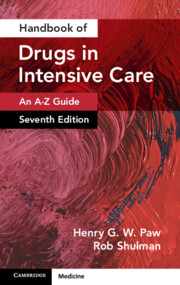Book contents
- Handbook of Drugs in Intensive Care
- Handbook of Drugs in Intensive Care
- Copyright page
- Dedication
- Contents
- Introduction
- How to Use This Book
- Common Abbreviations
- Acknowledgements
- Drugs: An A–Z Guide
- Chapter A
- Chapter B
- Chapter C
- Chapter D
- Chapter E
- Chapter F
- Chapter G
- Chapter H
- Chapter I
- Chapter K
- Chapter L
- Chapter M
- Chapter N
- Chapter O
- Chapter P
- Chapter Q
- Chapter R
- Chapter S
- Chapter T
- Chapter V
- Chapter Z
- Short Notes
- Appendices
- Drug Index
Chapter Q
from Drugs: An A–Z Guide
- Handbook of Drugs in Intensive Care
- Handbook of Drugs in Intensive Care
- Copyright page
- Dedication
- Contents
- Introduction
- How to Use This Book
- Common Abbreviations
- Acknowledgements
- Drugs: An A–Z Guide
- Chapter A
- Chapter B
- Chapter C
- Chapter D
- Chapter E
- Chapter F
- Chapter G
- Chapter H
- Chapter I
- Chapter K
- Chapter L
- Chapter M
- Chapter N
- Chapter O
- Chapter P
- Chapter Q
- Chapter R
- Chapter S
- Chapter T
- Chapter V
- Chapter Z
- Short Notes
- Appendices
- Drug Index
Summary
This is an atypical antipsychotic agent that antagonizes a range of receptors, namely dopamine D1, D2, serotonin-2, alpha-1-adrenoceptor and histamine-1. Although licensed for conditions such as acute schizophrenia, mania, depression and bipolar disorder, there is emerging experience of using this agent as an alternative to haloperidol in delirium (see p. 358), particularly in patients who have a prolonged QT interval. A case series (Critical Care 2011; 15: R159) describes experience with a cohort of ICU patients. It has several attractive features: it is administered 12 hourly, has a relatively short half-life of 7 hours (12 hours for its active metabolite norquetiapine), is titratable and, importantly, has a lower incidence of QTc prolongation and fewer extrapyramidal symptoms than haloperidol.
- Type
- Chapter
- Information
- Handbook of Drugs in Intensive CareAn A-Z Guide, pp. 265 - 266Publisher: Cambridge University PressPrint publication year: 2025

